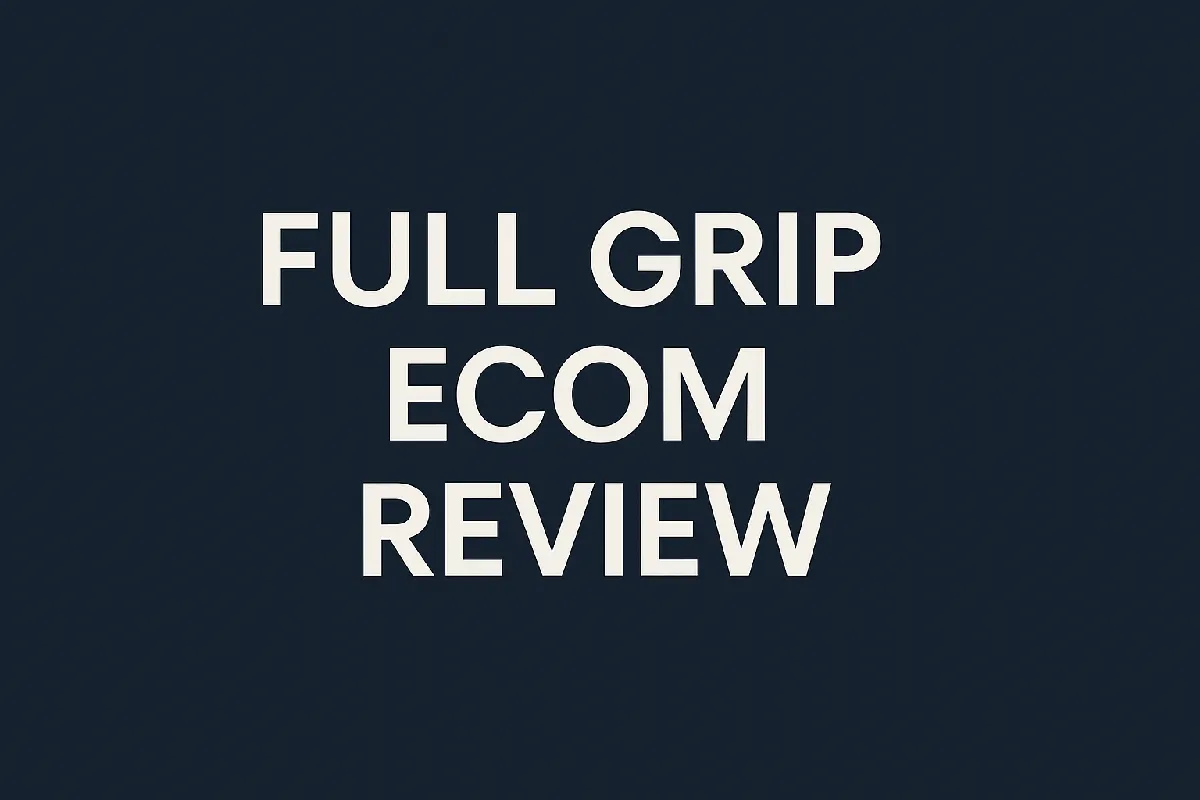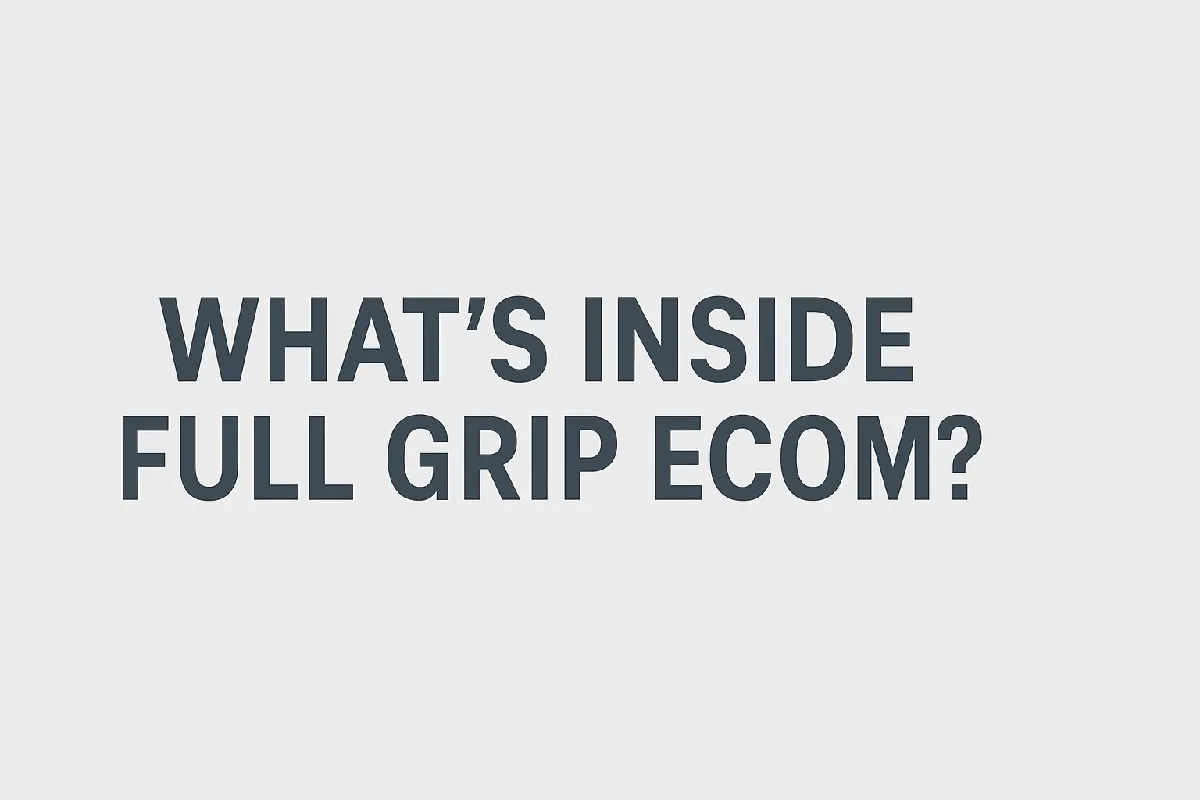Full Grip Ecom Review - What to Expect From This High-Ticket Ecommerce Program?
Welcome to this Full Grip Ecom review. The promise of a nearly hands-free e-commerce business caught my attention.
The company claims to build and run online stores for you — handling everything from setup and product research to fulfillment, customer service, and scaling.

That sounds appealing, especially if you don’t want to deal with the daily grind of dropshipping or running ads yourself.
The website emphasizes bold guarantees: stores launched within 30 days, margins of 20%–40%, and refund or buyback policies if your store doesn’t meet certain benchmarks.
They also highlight transparent reporting, showing clients live profit and loss dashboards.
It all seems designed to make the process feel safe and reliable, almost like you’re buying into a system rather than building one from scratch.
But digging deeper, the picture becomes more complex. Reviews from past clients paint very different experiences — some say they’ve seen sales and progress, while others report very low returns and frustration when trying to claim the promised buyback or refunds.
My own time looking into this left me cautious. The idea of outsourcing everything is convenient, but it also means giving up control and relying entirely on whether the team behind the scenes delivers.
Pros
– Hands-off structure with most tasks managed for you – Bold guarantees and transparency tools offered – Potential for margins that are higher than standard dropshipping
Cons
– High upfront investment required – Mixed track record of results and refund enforcement – Risk of relying completely on a third party to manage your business
If you’re curious about why many people still struggle even with done-for-you setups, this is something that breaks it all down here.
Who is The Founder of Full Grip Ecom?
From my own research, I learned that it’s run by Anri Davids and a team that they describe as being quite large — supposedly over 200 employees spread across different parts of the operation.
On the official site, they make it clear that they aren’t just a one-person show.
Instead, they position themselves as a full-scale company managing stores across platforms like Etsy, Walmart, eBay, and even TikTok.
That presentation caught my attention because I’ve seen plenty of smaller “automation” outfits that are little more than freelancers outsourcing tasks. Here, the pitch felt different.
They framed it more like a partnership — I put up the investment, and their team handled warehousing, fulfillment, customer support, and even marketing.
It sounded almost too good to be true, and that’s exactly what made me both curious and skeptical at the same time.
As I went through the site, I noticed how much emphasis they put on guarantees and transparency.
They promise things like product buybacks, store buybacks, and even live dashboards where I could supposedly track profit and loss in real time.
From my perspective, it felt like they knew potential clients would hesitate and wanted to build trust upfront by showing safety nets.
But the deeper I looked, the more I realized almost everything I was learning about the leadership and team came directly from their own material. Outside verification was thin.
That didn’t necessarily prove anything one way or another, but it did leave me cautious.
I’ve learned from experience that bold claims and polished presentations don’t always match what happens once you’re on the inside.
My Personal Experience With Full Grip Ecom

The onboarding process was straightforward, at least in my case. Communication was clear, and the setup steps didn’t take much time.
I was told my store would be live in about a month, and to their credit, it did launch within that window. At first, this gave me confidence that things were running as promised.
But once the store was up, reality set in. Sales trickled in slowly, and the big profit margins I had seen advertised didn’t immediately appear.
I remember checking the dashboards they provided and wondering if I had misunderstood how quickly results were supposed to come.
It wasn’t that nothing happened — I did see orders and some positive signs — but it didn’t match the smooth, fast progress I had been led to expect.
Over time, I also noticed how reliant I was on their team. Since they controlled most of the operation, I had very little influence on what was being tested or how changes were made.
That lack of control made me uneasy, especially when results weren’t strong.
I couldn’t step in and fix things myself, which left me waiting and hoping their system would eventually deliver.
Looking back, my experience taught me that while a hands-off approach feels convenient, it also means trusting someone else with all the levers that usually decide whether a store sinks or swims.
Going through that process made me realize how often people step into these systems expecting certainty, only to discover that the results can feel very different once you’re inside.
If you’ve ever wondered why that happens so often, you’ll see it explained here.
What is Full Grip Ecom?
They called it a 99% hands-off model, with the remaining 1% being the small amount of onboarding I had to do at the start.
The program covered a lot more than I expected. They claimed to take care of product sourcing, store branding, marketplace approvals, ad management, fulfillment, customer support, and even returns.
That full-service approach was part of what drew me in. I had been through enough trial-and-error in e-commerce to know how much time each of those pieces can consume, so the thought of outsourcing it all to a team with experience sounded efficient.
They also leaned heavily on their guarantees. I read about their product buyback promise, which meant that if certain items didn’t sell in a set time frame, they would replace or buy them back.
On top of that, there was a store buyback guarantee if my store didn’t recoup the initial investment in three years.
Add in the live profit-and-loss dashboards, and it felt like they were trying to make the system as transparent as possible.
At the same time, I couldn’t help but notice how bold these claims were. My gut told me that while the promises sounded great, it was worth questioning how often those guarantees were actually honored in practice.
That’s what made me cautious, even while I was intrigued by the idea of such a complete hands-free setup.
How Much Does Full Grip Ecom Cost & What's Their Refund Policy?
The starting price was around $15,000 for them to build and manage a store. On top of that, they take a 50/50 profit split, meaning half of the earnings from the store go back to them.
To me, that setup made it feel less like I was simply buying a service and more like I was investing in a partnership where they shared in the upside.
The guarantees they advertised were a big part of how they justified the price.
One was a product buyback guarantee — if a product didn’t sell within about sixteen months, they promised to either replace it or buy it back.
Another was a store buyback guarantee, where they claimed that if my store didn’t recoup the initial investment within three years, they’d cover the difference.
On paper, these policies made the high upfront cost feel less intimidating, almost like a safety net against worst-case scenarios.
But when I dug deeper, I noticed that the guarantees weren’t as airtight as they sounded.
I came across people who said they had difficulty actually collecting refunds, even when they thought they qualified.
From my perspective, that changed how I viewed the risk. The promises sounded strong, but I knew they ultimately depended on whether the company would honor them without hassle.
So for me, the pricing came down to more than just the dollar amount. It was a question of trust.
I had to weigh whether I believed the guarantees would really protect my investment — and that made the decision feel a lot heavier than just comparing price tags.
What's Inside Full Grip Ecom?

From my experience, most programs either teach you how to build a store or maybe give partial support, but here the pitch was very different.
They described it as “99% done-for-you,” and in practice, that meant I barely had to lift a finger beyond the initial onboarding.
The features covered nearly every aspect of running a store. They promised to handle product research, finding items with healthy margins and steady demand.
They also managed store creation and branding, which included marketplace approvals on platforms like Etsy, Walmart, or eBay.
Beyond that, their team took over marketing management, customer support, returns and refunds, and even scaling once the store gained traction.
On paper, it looked like they were removing all the friction points that usually make e-commerce so overwhelming.
One detail that stood out to me was the promise of live profit and loss dashboards.
They emphasized transparency by saying I could log in anytime to see exactly how the store was performing.
That gave me some peace of mind at the beginning, since I felt I could track what was happening without constantly emailing someone for updates.
Still, there were aspects that left me uneasy. Having everything run by someone else sounded convenient, but it also meant I had no real control.
If results weren’t there, I couldn’t adjust the ads, test new products, or change the direction of the store myself.
From my perspective, the features were impressive, but they came with the trade-off of putting all the levers of success in someone else’s hands.
What Are Full Grip Ecom's Student Results & Testimonials?
I paid a lot of attention to the results and testimonials they showcased. On their website and in some of their marketing, they highlighted stories of clients who supposedly hit strong margins and steady growth.
Some examples mentioned stores becoming profitable within months, while others emphasized the transparency of their dashboards as proof of real results. Seeing those stories definitely made the program sound convincing at first.
But when I looked beyond their own platform, I started to notice a very different picture.
On review sites, I found clients who claimed they had invested large sums — sometimes over thirty thousand dollars — only to see monthly returns of just a few hundred dollars.
A few even said that when they tried to use the buyback guarantees, they were given the runaround instead of a straightforward refund.
Reading those comments made me question how typical the “success stories” really were.
In my own case, my results were modest. I did see orders come through, and it wasn’t as if the store just sat idle, but the returns were nowhere near what I expected based on the promises.
Instead of quick scaling, I found myself waiting month after month for things to pick up.
The lack of direct control made it frustrating, because I couldn’t step in and try new approaches when results lagged.
From my experience, the student testimonials felt like a mix of best-case scenarios and genuine struggles.
Some people clearly saw progress, while others were left disappointed. For me, the truth sat somewhere in between: I saw movement, but not enough to match the bold results I had been shown upfront.
Pros and Cons of Full Grip Ecom
The fact that they handled store setup, product research, customer service, and even fulfillment meant I didn’t have to spend hours figuring out technical details or learning how to negotiate with suppliers.
That level of support freed up my time and removed a lot of the uncertainty that usually comes with starting an online store.
I also liked the idea of the live dashboards. Being able to track sales and expenses in real time gave me more visibility than I expected from a “hands-off” program.
But there were downsides that stood out just as strongly. The biggest one was the price.
Putting up fifteen thousand dollars upfront, plus giving up half of the profits, was a significant commitment.
Once I added in the mixed reviews about whether refunds were honored, I couldn’t help but feel uneasy about the financial risk.
Another drawback was the lack of control. Since the team managed almost everything, I had little ability to step in when results weren’t strong.
I had to wait and trust that they were testing the right products or running the right strategies.
That made me feel more like a passive investor than a business owner.
The last con was the gap between expectations and reality. The marketing leaned heavily on big wins and best-case scenarios, but my actual results were far slower and less dramatic.
For me, the pros were about structure and support, while the cons came down to cost, control, and uncertainty around outcomes.
Who is Full Grip Ecom Best For?
The upfront price alone makes it clear that it’s aimed at people who already have capital set aside and are willing to put it at risk.
Anyone hoping to dip a toe into e-commerce with a small budget would find this model overwhelming.
The setup also favors people who want to stay out of the day-to-day grind. Everything is managed on your behalf — product research, fulfillment, customer service, and marketing.
That kind of convenience can be attractive, but it also shifts your role into more of an investor than an operator.
If the idea of being hands-off sounds like a relief, this structure has appeal.
If you’d rather be directly involved in testing ads or building customer relationships, the lack of control will likely feel frustrating.
Patience plays a big role too. Stores don’t automatically scale in the first few months, no matter how the guarantees are framed.
The early results I saw were steady but underwhelming, and it took time before any real traction showed.
Someone expecting quick wins would be let down, but a person willing to ride out slow progress may handle the pace better.
Overall, this program is best suited for people with disposable capital, a tolerance for risk, and the mindset to treat it like an investment that takes time.
Those looking for a hands-on learning experience or rapid returns won’t find what they’re hoping for here.
Final Verdict
The convenience of having everything managed was real. The onboarding was smooth, the dashboards gave visibility into performance, and the idea of skipping over the grind of building a store from scratch had obvious appeal.
On paper, the structure looked solid and the guarantees offered some sense of security.
The reality, though, was more complicated. The high upfront cost, combined with the ongoing profit split, made the investment feel heavy.
Results were slower and less dramatic than I expected, and the lack of control over decisions often left me frustrated.
Even when sales came through, it never felt like I was steering the business — more like I was along for the ride, hoping the team behind the scenes knew exactly what they were doing.
That doesn’t make the program a scam, but it does highlight the gap between bold promises and what actually happens once you’re inside.
For someone with capital to spare, a willingness to wait things out, and a preference for being hands-off, the model could fit.
For anyone expecting quick returns or hoping to learn e-commerce directly, it’s not the right match.
The biggest takeaway for me is that no system is ever truly hands-free. Outsourcing the work shifts the responsibility, but it doesn’t erase the risks.
Anyone considering this route should weigh whether the convenience is worth the cost and whether they’re comfortable putting their business entirely in someone else’s hands.
What stood out most to me was how easy it is to believe that outsourcing will solve everything, when in reality, it often just shifts the challenges around.
If you want a clearer look at why so many people struggle to see the outcomes they expect, you can see this here.